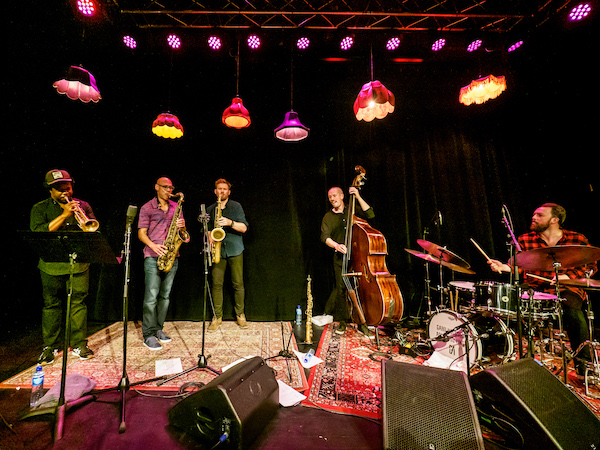Oct 28, 2025 10:47 AM
In Memoriam: Jack DeJohnette, 1942–2025
Jack DeJohnette, a bold and resourceful drummer and NEA Jazz Master who forged a unique vocabulary on the kit over his…

Trumpeter Ambrose Akinmusire (left) and saxophonist Joshua Redman join Gard Nilssen Acoustic Unity during a performance at the Molde Jazz Festival in Molde, Norway.
(Photo: Thor Egil Leirtrø)Gard Nilssen’s Supersonic Orchestra—a juggernaut of an ensemble incorporating three rhythm sections of bass and trap drums surrounded by a phalanx of brass—delivered a nearly nonstop 90-minute debut at the Plassen auditorium inside the Teatret Värt on July 19.
It came late in the programing of the 59th annual Molde Jazz Festival, which ran July 13-20, but still was an illustrative display.
Nilssen, a noted Norwegian drummer, composer and bandleader, served as the festival’s Artist-in-Residence. Earlier in the week, he performed in various settings, including with his remarkable Acoustic Unity trio, and sPacemoNkey—an experimental free-jazz/techno duo with pianist Morten Qvenild. sPacemoNkey joined forces with Storløkken og Westerhus, another intrepid duo consisting of guitarist Stian Westerhus and keyboardist Ståle Storløkken. But with the 18-piece orchestra, Nilssen made his grandest statement with the world-premiere of “If You Listen Carefully, The Music Is Yours,” the title a reference to Val Wilner’s classic 1977 book, As Serious as Your Life.
The music kicked off with aggressive sonic blasts and serrated rhythms that threatened to fatigue even the most empathic listener, especially when the horns issued swarms of harmonic dissonance and jaunty melodicism. But as the piece progressed, it revealed more beauty and brains during some of the quieter, more hymnal moments. Despite its size, the music’s momentum never was sluggish, whether shifting from 4/4-swing to transfixing waltz time, or 6/8 West African-inspired grooves to Trinidadian soca syncopations. That agility was achieved by having the different rhythm sections alternate as the fulcrum of sound, even when individual drummers and bassists crisscrossed and connected with their counterparts amid the protean rhythmic bed.
The music allotted plenty of room for all the members of the Supersonic Orchestra to display sublime individual solos, too. In addition to Nilssen’s outstanding rhythmic virtuosity, the orchestra’s other two drummers—Håkon Mjåset Johansen and Hans Hulbækmo—demonstrated superb improvisational pliancy and capricious imagination, especially when incorporating miniature percussion.
The next day, Nilssen returned to the Plassen auditorium with Amgala Temple for the festival’s closing midnight concert. While Amgala Temple is set up as a trio—comprised of Nilssen, guitarist Amund Maarud and bassist/keyboardist/slide guitarist Lars Horntveth—it unleashed a sonic boom that rivaled the Supersonic Orchestra. The ensemble channeled the high-voltage energy of Tony Williams’ Lifetime as it engaged in dark, adrenaline-pumping excursions steered by Nilssen’s muscular drumming that occasionally alluded to Clyde Stubblefield’s funky rhythms. But it was Horntveth’s deft navigation among keyboards and axes, especially his wondrous work on lap steel, that stole the show.
Other highlights from the Norwegian side of the festival included reedist and composer Mathilde Grooss Viddal’s performance with her tenet, FriEnsemblet. Together, they focused on a commissioned work involving Norwegian ballads dating back to the medieval period.
Tenor saxophonist and opera singer Håkon Kornstad also delivered a transfixing, if lofty, performance at the Molde Cathedral on the afternoon of July 19. Accompanied by accordionist Frode Haltli and bassist Mats Eilertsen, the leader launched into a mesmerizing modernization of classic music by the likes of Tosti, Wagner and Verdi with brilliant invention, especially when combining vintage prerecorded operas, emotional immediacy and puckish abandonment.
Some of the highlights from the U.S. contingent included Joshua Redman’s Still Dreaming, his homage to the Old and New Dreams ensemble, which featured his father, Dewey. With a slight lineup change that featured Dave King in the drummer’s seat instead of Brian Blade, Still Dreaming delivered barreling, spatially aware excursions with its feisty reading of Don Cherry’s chant-like “Mopti” and Redman’s own “Unanimity.” Organist Larry Goldings, drummer Bill Stewart and guitarist Peter Bernstein illustrated the advantages of long-established rapport with a smoldering trio set that included delightful originals, such as Stewart’s “Don’t Ever Call Me Again” and Golding’s “Fagen,” and splendid treatments of Wayne Shorter’s “United” and George and Ira Gershwin’s “Embraceable You.” DB

Jack DeJohnette boasted a musical resume that was as long as it was fearsome.
Oct 28, 2025 10:47 AM
Jack DeJohnette, a bold and resourceful drummer and NEA Jazz Master who forged a unique vocabulary on the kit over his…

D’Angelo achieved commercial and critical success experimenting with a fusion of jazz, funk, soul, R&B and hip-hop.
Oct 14, 2025 1:47 PM
D’Angelo, a Grammy-winning R&B and neo-soul singer, guitarist and pianist who exerted a profound influence on 21st…

Kandace Springs channeled Shirley Horn’s deliberate phrasing and sublime self-accompaniment during her set at this year’s Pittsburgh International Jazz Festival.
Sep 30, 2025 12:28 PM
Janis Burley, the Pittsburgh International Jazz Festival’s founder and artistic director, did not, as might be…

Jim McNeely’s singular body of work had a profound and lasting influence on many of today’s top jazz composers in the U.S. and in Europe.
Oct 7, 2025 3:40 PM
Pianist Jim McNeely, one of the most distinguished large ensemble jazz composers of his generation, died Sept. 26 at…

Drummond was cherished by generations of mainstream jazz listeners and bandleaders for his authoritative tonal presence, a defining quality of his style most apparent when he played his instrument unamplified.
Nov 4, 2025 11:39 AM
Ray Drummond, a first-call bassist who appeared on hundreds of albums as a sideman for some of the top names in jazz…